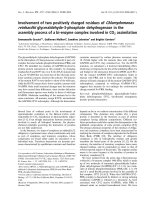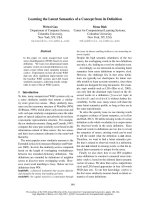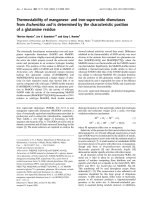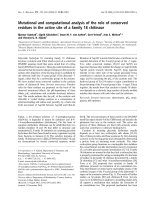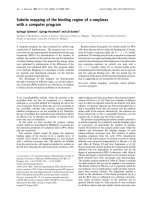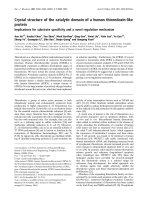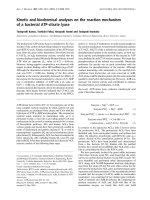The five dysfunctions of a team a leadership fable
Bạn đang xem bản rút gọn của tài liệu. Xem và tải ngay bản đầy đủ của tài liệu tại đây (1.4 MB, 242 trang )
The Five
Dysfunctions
of aTeam
A LEADERSHIP FABLE
Patrick Lencioni
01_960756_ffirs_16.qxd 1/13/06 8:57 AM Page iii
01_960756_ffirs_16.qxd 1/13/06 8:57 AM Page ii
Also by Patrick Lencioni
Leadership Fables
The Five Temptations of a CEO
The Four Obsessions of an Extraordinary Executive
Death by Meeting
Silos, Politics, and Turf Wars
Field Guide
Overcoming the Five Dysfunctions of a Team
01_960756_ffirs_16.qxd 1/13/06 8:57 AM Page i
01_960756_ffirs_16.qxd 1/13/06 8:57 AM Page ii
The Five
Dysfunctions
of aTeam
A LEADERSHIP FABLE
Patrick Lencioni
01_960756_ffirs_16.qxd 1/13/06 8:57 AM Page iii
Copyright © 2002 by Patrick Lencioni.
Published by Jossey-Bass
A Wiley Imprint
989 Market Street, San Francisco, CA 94103-1741 www.josseybass.com
No part of this publication may be reproduced, stored in a retrieval system, or transmitted in any
form or by any means, electronic, mechanical, photocopying, recording, scanning, or otherwise,
except as permitted under Section 107 or 108 of the 1976 United States Copyright Act, without
either the prior written permission of the publisher, or authorization through payment of the
appropriate per-copy fee to the Copyright Clearance Center, Inc., 222 Rosewood Drive, Danvers,
MA 01923, 978-750-8400, fax 978-646-8600, or on the Web at www.copyright.com. Requests to the
publisher for permission should be addressed to the Permissions Department, John Wiley &
Sons, Inc., 111 River Street, Hoboken, NJ 07030, 201-748-6011, fax 201-748-6008, or online at
/>Limit of Liability/Disclaimer of Warranty: While the publisher and author have used their best
efforts in preparing this book, they make no representations or warranties with respect to the
accuracy or completeness of the contents of this book and specifically disclaim any implied
warranties of merchantability or fitness for a particular purpose. No warranty may be created or
extended by sales representatives or written sales materials. The advice and strategies contained
herein may not be suitable for your situation. You should consult with a professional where
appropriate. Neither the publisher nor author shall be liable for any loss of profit or any other
commercial damages, including but not limited to special, incidental, consequential, or other
damages.
Readers should be aware that Internet Web sites offered as citations and/or sources for further
information may have changed or disappeared between the time this was written and when it is
read.
Jossey-Bass books and products are available through most bookstores. To contact Jossey-Bass
directly call our Customer Care Department within the U.S. at 800-956-7739, outside the U.S. at
317-572-3986, or fax 317-572-4002.
Jossey-Bass also publishes its books in a variety of electronic formats. Some content that appears
in print may not be available in electronic books.
Library of Congress Cataloging-in-Publication Data
Lencioni, Patrick, 1965–
The five dysfunctions of a team : a leadership fable / Patrick Lencioni.
p. cm.
ISBN 0-7879-6075-6
1. Teams in the workplace. I. Title.
HD66 .L456 2002
658.4'036—dc21 2001008099
Printed in the United States of America
FIRST EDITION
HB Printing 20 19 18 17 16
01_960756_ffirs_16.qxd 1/13/06 8:57 AM Page iv
v
Introduction vii
The Fable 1
Luck 3
Part One: Underachievement 5
Part Two: Lighting the Fire 27
Part Three: Heavy Lifting 115
Part Four: Traction 171
The Model 185
An Overview of the Model 187
Team Assessment 191
Understanding and Overcoming
the Five Dysfunctions 195
A Note About Time: Kathryn’s Methods 221
A Special Tribute to Teamwork 223
Acknowledgments 225
About the Author 229
CONTENTS
02_960756_ftoc.qxd 3/25/05 9:55 AM Page v
To Dad, for teaching me the value of work.
And to Mom, for encouraging me to write.
03_960756_flast.qxd 3/25/05 9:59 AM Page vi
INTRODUCTION
Not finance. Not strategy. Not technology. It is teamwork
that remains the ultimate competitive advantage, both be-
cause it is so powerful and so rare.
A friend of mine, the founder of a company that grew
to a billion dollars in annual revenue, best expressed the
power of teamwork when he once told me, “If you could
get all the people in an organization rowing in the same di-
rection, you could dominate any industry, in any market,
against any competition, at any time.”
Whenever I repeat that adage to a group of leaders, they
immediately nod their heads, but in a desperate sort of way.
They seem to grasp the truth of it while simultaneously sur-
rendering to the impossibility of actually making it happen.
And that is where the rarity of teamwork comes into
play. For all the attention that it has received over the years
from scholars, coaches, teachers, and the media, teamwork
is as elusive as it has ever been within most organizations.
The fact remains that teams, because they are made up of
imperfect human beings, are inherently dysfunctional.
vii
03_960756_flast.qxd 3/25/05 9:59 AM Page vii
viii
Introduction
But that is not to say that teamwork is doomed. Far
from it. In fact, building a strong team is both possible and
remarkably simple. But it is painfully difficult.
That’s right. Like so many other aspects of life, team-
work comes down to mastering a set of behaviors that are
at once theoretically uncomplicated, but extremely difficult
to put into practice day after day. Success comes only for
those groups that overcome the all-too-human behavioral
tendencies that corrupt teams and breed dysfunctional pol-
itics within them.
As it turns out, these principles apply to more than just
teamwork. In fact, I stumbled upon them somewhat by ac-
cident in my pursuit of a theory about leadership.
A few years ago I wrote my first book, The Five Temp-
tations of a CEO, about the behavioral pitfalls that plague
leaders. In the course of working with my clients, I began
to notice that some of them were “misusing” my theories in
an effort to assess and improve the performance of their
leadership teams—and with success!
And so it became apparent to me that the five tempta-
tions applied not only to individual leaders but, with a few
modifications, to groups as well. And not just within cor-
porations. Clergy, coaches, teachers, and others found that
these principles applied in their worlds as much as they did
in the executive suite of a multinational company. And that
is how this book came to be.
Like my other books, The Five Dysfunctions of a Team
begins with a story written in the context of a realistic but
03_960756_flast.qxd 3/25/05 9:59 AM Page viii
ix
Introduction
fictional organization. I have found that this allows read-
ers to learn more effectively by losing themselves in a story
and by being able to relate to the characters. It also helps
them understand how these principles can be applied in a
nontheoretical, real-world environment, where the pace of
work and the volume of daily distractions make even the
simplest of tasks seem arduous.
In order to help you apply the material in your own or-
ganization, a brief section following the story outlines the
five dysfunctions in detail. That section also includes a team
assessment and suggested tools for overcoming the issues
that might be plaguing your team.
Finally, although this book is based on my work with
CEOs and their executive teams, its theories are applica-
ble for anyone interested in teamwork, whether you lead a
small department within a company or are simply a mem-
ber of a team that could use some improvement. Whatever
the case may be, I sincerely hope it helps your team over-
come its particular dysfunctions so that it can achieve more
than individuals could ever imagine doing alone. That, after
all, is the real power of teamwork.
03_960756_flast.qxd 3/25/05 9:59 AM Page ix
03_960756_flast.qxd 3/25/05 9:59 AM Page x
The Fable
03Lencioni/Fable 2/10/02 3:29 PM Page 1
03Lencioni/Fable 2/10/02 3:29 PM Page 2
LUCK
O
nly one person thought Kathryn was the right choice to be-
come CEO of DecisionTech, Inc. Luckily for her, that per-
son was the Chairman of the board.
And so, less than a month after the previous chief ex-
ecutive had been removed, Kathryn Petersen took the reins
of a company that just two years earlier had been one of
the most talked-about, well-funded, and promising start-up
companies in the recent history of the Silicon Valley. She
could not have known just how far from grace the com-
pany had fallen in such a short period of time, and what
the next few months had in store for her.
3
04Lencioni/Luck 2/10/02 3:30 PM Page 3
04Lencioni/Luck 2/10/02 3:30 PM Page 4
PART ONE
❖
Under-
achievement
05Lencioni/Part 1 2/10/02 3:30 PM Page 5
05Lencioni/Part 1 2/10/02 3:30 PM Page 6
BACKSTORY
D
ecisionTech was located in Half Moon Bay, a foggy, coastal
farming town just over the hills from the San Francisco Bay.
It was not technically part of the Silicon Valley, but the Val-
ley is not so much a geographical entity as a cultural one.
And DecisionTech certainly fit within that world.
It had the most experienced—and expensive—executive
team imaginable, a seemingly indestructible business plan,
and more top-tier investors than any young company could
hope for. Even the most cautious venture firms were lining
up to invest, and talented engineers were submitting their
resumés before the company had leased an office.
But that was almost two years earlier, which is a life-
time for a technology start-up. After its first few euphoric
months of existence, the company began experiencing a
series of ongoing disappointments. Critical deadlines
started to slip. A few key employees below the executive
level unexpectedly left the company. Morale deteriorated
7
06Lencioni/Backstory 2/10/02 3:31 PM Page 7
8
The Five Dysfunctions of a Team
gradually. All of this in spite of the considerable advantages
that DecisionTech had amassed for itself.
On the two-year anniversary of the firm’s founding, the
board unanimously agreed to “ask” Jeff Shanley, the com-
pany’s thirty-seven-year-old CEO and cofounder, to step
down. He was offered the job of heading business devel-
opment, and to the surprise of his colleagues, he accepted
the demotion, not wanting to walk away from a potentially
huge payout should the company eventually go public.
And even in the difficult economic climate of the Valley,
the company had every reason to go public.
None of DecisionTech’s 150 employees were shocked
by Jeff’s removal. While most of them seemed to like him
well enough personally, they couldn’t deny that under his
leadership the atmosphere within the company had become
increasingly troubling. Backstabbing among the executives
had become an art. There was no sense of unity or cama-
raderie on the team, which translated into a muted level of
commitment. Everything seemed to take too long to get
done, and even then it never felt right.
Some boards might have been more patient with a
stumbling executive team. DecisionTech’s was not. There
was just too much at stake—and too high a profile—to
watch the company waste away because of politics. Deci-
sionTech had already developed a reputation within the
Valley for being one of the most political and unpleasant
places to work, and the board couldn’t tolerate that kind
06Lencioni/Backstory 2/10/02 3:31 PM Page 8
9
Backstory
of press, especially when the future had looked so promis-
ing just a couple of years earlier.
Someone had to be accountable for the mess, and Jeff
was the man at the top. Everyone seemed relieved when
the board announced the decision to remove him.
Until three weeks later, when Kathryn was hired.
06Lencioni/Backstory 2/10/02 3:31 PM Page 9
KATHRYN
The executives couldn’t agree on which of Kathryn’s fea-
tures presented the biggest problem. There were so many.
First, she was old. Ancient, at least by Silicon Valley stan-
dards. Kathryn was fifty-seven.
More important, she had no real high-tech experience
other than serving as a board member of Trinity Systems,
a large technology company in San Francisco. Most of her
career had been spent in operational roles with decidedly
low-tech companies, the most notable of which was an au-
tomobile manufacturer.
But more than her age or experience, Kathryn just didn’t
seem to fit the DecisionTech culture.
She had started her career in the military, then married
a teacher and basketball coach at a local high school. After
raising three boys, she taught seventh grade for a few years
until she discovered her affinity for business.
At the age of thirty-seven, Kathryn enrolled in a three-
year business school night program, which she completed
a semester early at Cal State Hayward, which was not ex-
10
07Lencioni/Kathryn 2/10/02 3:31 PM Page 10
11
Kathryn
actly Harvard or Stanford. She then spent the next fifteen
years in and around manufacturing, until her retirement at
the age of fifty-four.
The fact that Kathryn was a woman was never an issue
for the executive team; two of them were women them-
selves. With much of their collective experience coming
from the somewhat progressive world of high tech, most
had worked for women at some time during their careers.
But even if her gender had been a problem for anyone on
the team, it would have been dwarfed by her glaring cul-
tural mismatch.
There was just no mistaking the fact that, on paper,
Kathryn was an old school, blue-collarish executive. That
presented a stark contrast to the DecisionTech executives
and middle managers, most of whom had little experience
working outside of the Valley. Some of them even liked to
brag that they hadn’t worn a suit—outside of a wedding—
since graduating from college.
It was no surprise that after first reading her resumé,
board members questioned the Chairman’s sanity when
he suggested they hire Kathryn. But he eventually wore
them down.
For one, the board believed their Chairman when he
flat out assured them that Kathryn would succeed. Second,
he had been known to have extremely good instincts about
people, notwithstanding the problem with Jeff. He certainly
wouldn’t make two mistakes in a row, they reasoned.
But perhaps most important of all (though no one would
07Lencioni/Kathryn 2/10/02 3:31 PM Page 11
12
The Five Dysfunctions of a Team
admit it), DecisionTech was in a desperate situation. The
Chairman insisted that there weren’t too many capable ex-
ecutives willing to take on such a messy job given the cur-
rent state of affairs at the scarred company. “We should
consider ourselves lucky to have such a capable leader as
Kathryn available,” he successfully argued.
Whether or not that was true, the Chairman was deter-
mined to hire someone he knew and could trust. When
he called Kathryn to tell her about the job, he certainly could
not have known that he would be regretting the decision
just a few weeks later.
07Lencioni/Kathryn 2/10/02 3:31 PM Page 12
RATIONALE
N
o one was more surprised about the offer than Kathryn. Al-
though she had known the Chairman for many years on a
personal level (Kathryn had actually first met him when her
husband coached his oldest son in high school), she could
not have imagined that he thought so highly of her as an
executive.
Most of their relationship had been social, centering
around family, school, and local athletics. Kathryn assumed
that the Chairman had little idea about her life outside her
role as a mother and coach’s wife.
In fact, the Chairman had followed Kathryn’s career
with interest over the years, amazed at how successful she
had become with such relatively modest training. In less
than five years, she had become chief operating officer of
the Bay Area’s only automobile manufacturing plant, a U.S
Japanese joint venture. She held that job for the better part
of a decade and made the plant one of the most success-
ful cooperative enterprises in the country. And while the
13
08Lencioni/Rationale 2/10/02 3:32 PM Page 13


